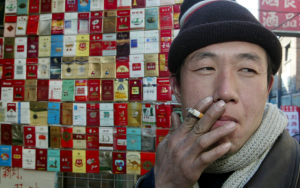Peter Hessler’s Country Driving illustrates the everyday life and culture of Chinese citizens through descriptive accounts of his immersive travels around the People’s Republic. While living in the rural village of Sancha, Hessler describes the idiosyncrasies of Chinese society; however, the social implications of cigarettes in China stand out as a differentiating feature of the country’s cultural landscape. While the health effects of smoking are recognized by the Chinese people, cigarettes are an essential part of business and social interaction, a reality supported by Hessler’s discussion with a young Wenzhou businessman who stated ” I know it’s not good for you, but I’m young so I don’t feel any effect. And its important for business. If you’re trying to pull guanxi with somebody, you have to take him out to dinner, and you need to smoke and drink with him” (Hessler, 233).
The development of “guanxi” in China, a term which represents “the system of social networks and influential relationships that facilitate business and other dealings” (Oxford Dictionary), frequently requires cigarettes and the brand of smokes one carries offers conveys the owner’s social status and importance. The Chinese cigarette market is state owned and the industry, which produces over 2.3 trillion cigarettes annually, features countless brands: Red Plum Blossom Whites (the cigarettes of Bejing peasants), Red Pagoda Mountain (the choice brand of average city folk), Zhongnanhai Lights (the smokes of Middle-class entrepreneurs), and State Express 555 (the brand for businessmen with a flair for the foreign) (Hessler, 232). Interactions between businessmen often include the exchange of cigarettes, and the quality of product a person carries delivers a number of silent social keys within the Chinese business community. Hessler notes “you offer a smoke at certain moments , and you receive them at others; the give-and-take establishes a level of communication. And sometimes the absence of an exchange marks boundaries” (232).
While the state-run tobacco industry creates a fascinating social atmosphere to observe, smoking in China leads to over one million deaths a year, a figure that is forecasted to double by 2025. The conflicting efforts of capitalist enterprise and socialist health service add contextual depth to cigarette smoking in China, with the country’s Center for Disease Control and Prevention releasing studies in 200 that showed the health-related costs of smoking vastly outweigh the revenue benefits. With the development of nationwide health insurance, the Chinese government’s revenue will be drawn upon to cover the damages the state-run tobacco industry creates. This political development may alter the cultural stigma surrounding cigarettes and could possibly lead to new forms of developing guanxi.
Governments are not unitary actors, but comprised of many subunits that not infrequently have competing interests. In the case of tobacco, who gets the tax revenue? the profits from making cigarettes? Who is in charge of health? We learn a lot if we can spell out such details.
One thing I think about while reading this is the issue that China is having with an aging working class that will outnumber the class that follows them. The issue of funding the elderly will be even more difficult if the health of China diminishes because of factors like cigarettes/drinking/pollution/etc
This may have been the subject of study already, but I’ve always been curious about the government’s relationship with cigarette culture. You wrote that the health issues that arise from cigarette usage far outweigh the revenue gained by production, but it that fact alone enough to get the government to take action? In the US, schools teach the dangers of cigarettes from an early age, and laws now restrict smoking spaces to the most tightly regulated or totally private spaces. Will the Chinese ever consider a similar path? Or is guanxi too ingrained to get the country to quit the habit?
If cigarettes decrease in popularity to the point where very few smoke, what alternatives might be used for the informal guanxi process? Continuously trading alcohol seems unfeasible, but there seems to be a lack of tradeable social items if cigarettes became taboo.